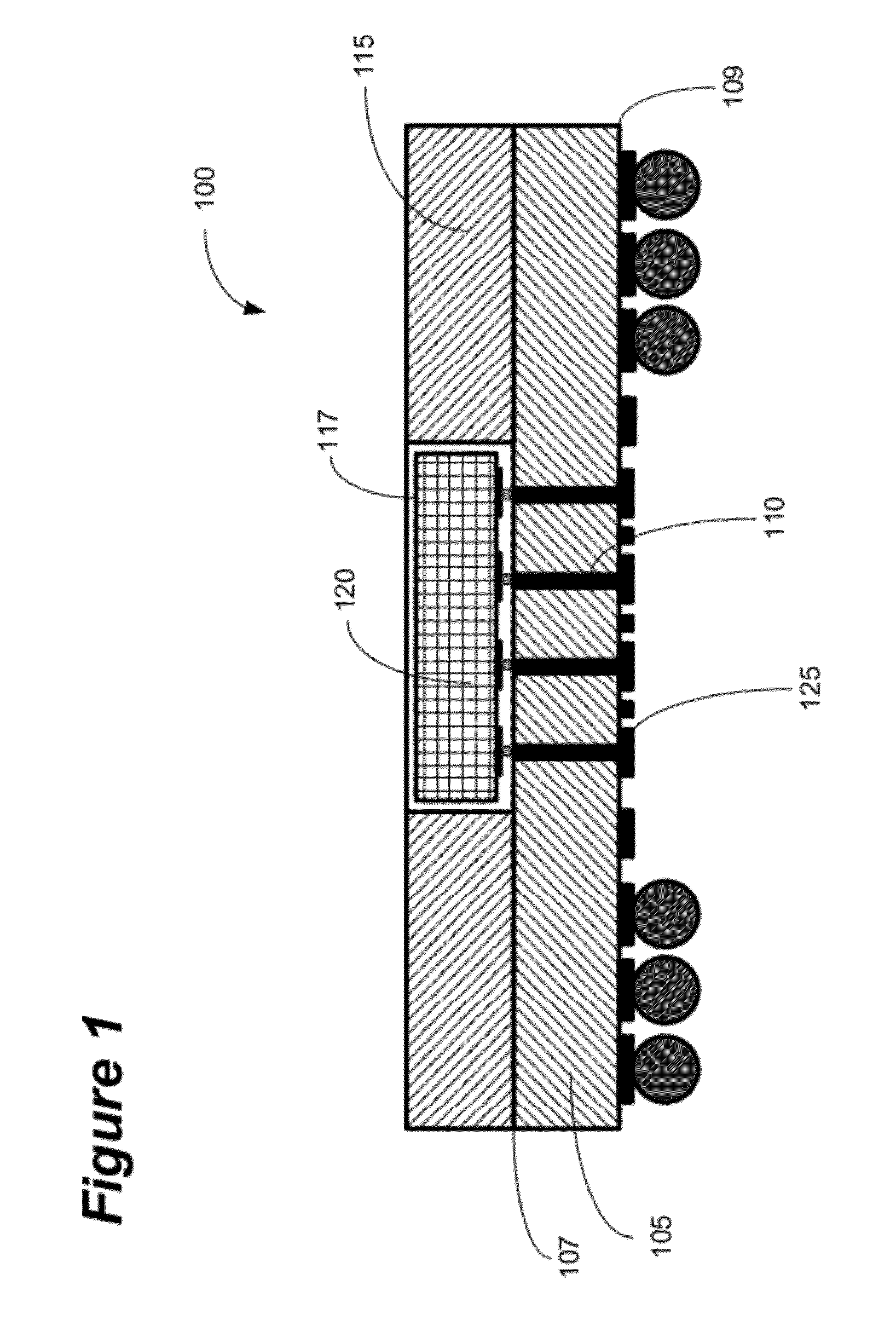Chip-last embedded interconnect structures and methods of making the same
a technology of embedded interconnects and chiplasts, applied in the direction of printed circuit non-printed electric components, immunological disorders, metabolism disorders, etc., can solve the problems of complex fabrication of multiple substrate layers and cavity formation of chips, and the associated cost of the substrate can be relatively high
- Summary
- Abstract
- Description
- Claims
- Application Information
AI Technical Summary
Problems solved by technology
Method used
Image
Examples
example 1
Chip-Last Embedding in 1-2 Metal Layer Structure
[0060]To achieve embedding of a 70-100 μm pitch area array I / O IC in core, an innovative two-metal layer substrate with ultra-high wiring density has been developed. The substrate structure is obtained by a two-step process—(1) fabrication of the thin core substrate with fine-pitch through-holes and fine line width and spaces, and (2) lamination of another thin-core substrate with pre-formed cavity for die embedding. This innovative approach has two major novelties—(1) ultra-fine metal lines and spaces on core laminate and (2) ultra-fine pitch through-holes. Instead of conventional wet etching process, the semi-additive process (SAP), usually used for build-up layer to achieve 10 μm and sub-10 μm lines and spaces was employed for fabrication of ultra-fine copper traces on the core. UV laser with 266 nanometers (nm) wavelength was employed for ultra-fine pitch (70-100 μm) through-holes to meet the fine-pitch flip-chip I / O needs.
TABLE 1P...
example 2
Fine Lines / Spaces on Core
[0062]To fabricate 7-15 μm line widths and spaces for copper circuitry on core laminate, the SAP method was employed instead of the conventional wet etching method. The first step is surface copper removal from a double sided copper clad laminate. Following copper removal, surface desmear and electroless copper plating was done to form a thin copper seed layer on the surface. Thereafter, a layer of dry film photo resist was laminated, exposed, and developed. Once the circuitry pattern was transferred to the photo resist, the electrolytic copper plating was carried out to plate the pattern in the photo-resist mold. After photo resist stripping, the final step is to remove the seed copper layer by micro etching. The process flow is described in FIG. 13.
[0063]The process mentioned above enables the wiring density of the 1+2+1 substrate within a two metal layer thin core with filled through holes and ultra fine lines. The reduction in layer count by elimination ...
example 3
Ultra-fine Pitch Area-Array Through-holes
[0064]The biggest challenge in achieving a substrate structure is fabrication of small diameter through-holes at ultra-fine pitch to meet the chip I / O footprint such that no escape routing is needed on the chip attach side of the module. The concern with ultra-fine pitch area array through-hole fabrication is the wall-to-wall distance of adjacent holes. If the wall-to-wall distance is not large enough, there is a high probability of encountering mechanical strength related issues. Therefore, in order to make ultra-fine pitch area-array through-holes, it is important to fabricate the holes with small diameter.
[0065]Currently, two techniques are most commonly used to make through-holes on glass-fiber reinforced laminates—(1) mechanical drilling, and (2) laser drilling. The most established through-hole technology is mechanical drilling. Mechanical drilling is an effective method for through-hole diameters larger than 150 μm. Current the-state-o...
PUM
 Login to View More
Login to View More Abstract
Description
Claims
Application Information
 Login to View More
Login to View More - R&D
- Intellectual Property
- Life Sciences
- Materials
- Tech Scout
- Unparalleled Data Quality
- Higher Quality Content
- 60% Fewer Hallucinations
Browse by: Latest US Patents, China's latest patents, Technical Efficacy Thesaurus, Application Domain, Technology Topic, Popular Technical Reports.
© 2025 PatSnap. All rights reserved.Legal|Privacy policy|Modern Slavery Act Transparency Statement|Sitemap|About US| Contact US: help@patsnap.com



